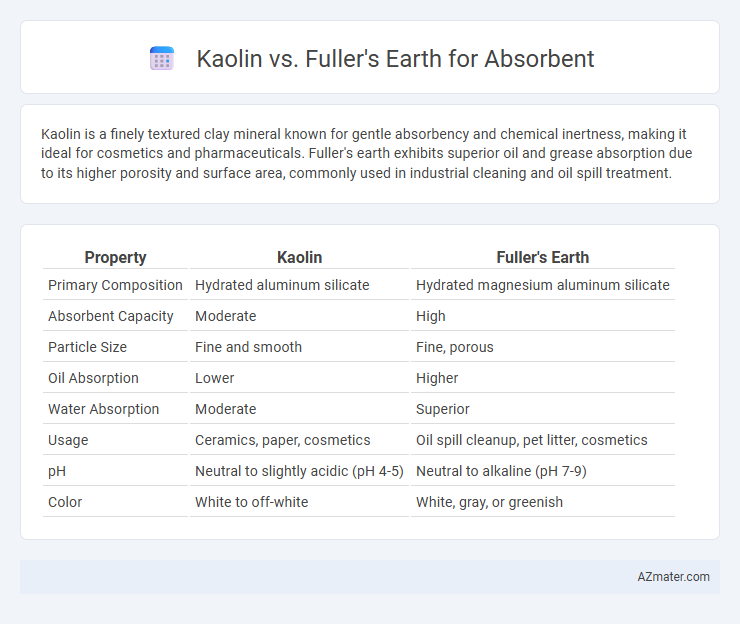Kaolin is a finely textured clay mineral known for gentle absorbency and chemical inertness, making it ideal for cosmetics and pharmaceuticals. Fuller's earth exhibits superior oil and grease absorption due to its higher porosity and surface area, commonly used in industrial cleaning and oil spill treatment.
Table of Comparison
| Property | Kaolin | Fuller's Earth |
|---|---|---|
| Primary Composition | Hydrated aluminum silicate | Hydrated magnesium aluminum silicate |
| Absorbent Capacity | Moderate | High |
| Particle Size | Fine and smooth | Fine, porous |
| Oil Absorption | Lower | Higher |
| Water Absorption | Moderate | Superior |
| Usage | Ceramics, paper, cosmetics | Oil spill cleanup, pet litter, cosmetics |
| pH | Neutral to slightly acidic (pH 4-5) | Neutral to alkaline (pH 7-9) |
| Color | White to off-white | White, gray, or greenish |
Introduction to Absorbent Clays
Absorbent clays such as Kaolin and Fuller's earth are widely used for their excellent adsorption properties in industrial and cosmetic applications. Kaolin, characterized by its fine particle size and mild absorbency, is ideal for gentle cleansing and fillers, while Fuller's earth possesses a higher oil and moisture absorption capacity, making it effective for deep cleaning and detoxifying. Understanding the compositional differences between these clays enhances their targeted use in products requiring specific absorption qualities.
What is Kaolin?
Kaolin, also known as china clay, is a naturally occurring soft white clay primarily composed of the mineral kaolinite, prized for its high absorbency and fine particle size. It effectively absorbs oils and moisture, making it a popular choice in cosmetics, pharmaceuticals, and industrial applications. Compared to Fuller's earth, kaolin offers gentler absorbent properties, suitable for sensitive skin and delicate formulations.
Understanding Fuller’s Earth
Fuller's earth, a naturally occurring clay rich in montmorillonite, is prized for its exceptional absorbent properties, particularly in removing oils, grease, and impurities from surfaces and liquids. Compared to kaolin, which primarily consists of kaolinite, Fuller's earth offers a higher cation exchange capacity, making it more effective for industrial applications such as oil spill cleanups, wastewater treatment, and cosmetics. Its porous structure and fine particle size enhance its ability to trap contaminants, positioning Fuller's earth as a superior absorbent material in many environmental and commercial processes.
Key Chemical Properties
Kaolin and Fuller's earth are both clay minerals known for their absorbent properties, with kaolin primarily composed of kaolinite (Al2Si2O5(OH)4) and Fuller's earth consisting mainly of montmorillonite or bentonite clays. Kaolin exhibits low cation-exchange capacity (CEC) and minimal swelling, making it effective for adsorbing oils and impurities without excessive expansion. Fuller's earth has a high CEC and significant swelling capacity, enhancing its ability to absorb heavy metals, oils, and moisture due to its layered silicate structure and larger surface area.
Absorption Capabilities Compared
Kaolin and Fuller's earth both exhibit strong absorption capabilities, but Fuller's earth typically has a higher absorption capacity due to its fine particle size and greater surface area, allowing it to effectively trap oils, impurities, and moisture. Kaolin, while also absorbent, tends to be gentler and is often preferred in cosmetic and pharmaceutical applications where mildness is crucial. Comparative studies show Fuller's earth can absorb up to 60-70% more oil than Kaolin, making it more efficient for industrial and cleaning uses.
Common Uses for Kaolin and Fuller’s Earth
Kaolin is primarily used in ceramics, paper coating, and as an absorbent in cosmetics to control oil and moisture due to its fine particle size and gentle nature. Fuller's earth excels in industrial applications such as oil spill cleanup, decolorizing oils, and as a heavy-duty absorbent in pet litter and cat litter products. Both materials absorb impurities, but Kaolin is preferred for delicate uses, while Fuller's earth is favored for robust, contaminant-heavy environments.
Safety and Environmental Impact
Kaolin offers excellent absorbent properties with minimal dust generation, reducing respiratory risks compared to Fuller's earth, which can produce irritant dust particles. Environmentally, Kaolin is more sustainable due to its lower impact mining processes and greater natural abundance, whereas Fuller's earth extraction often leads to significant habitat disruption and slower site rehabilitation. Both materials are biodegradable, but Kaolin's higher purity reduces potential soil and water contamination during disposal.
Cost Effectiveness
Kaolin offers a cost-effective absorbent option due to its widespread availability and lower extraction costs compared to Fuller's earth, which typically demands more intensive processing. Fuller's earth provides superior absorbency and oil absorption rates, but often at a higher price point that may not justify its use in large-scale, budget-conscious applications. For industries prioritizing cost efficiency over maximum absorbency, kaolin presents a balanced solution with competitive performance and lower overall expenses.
Market Availability and Sourcing
Kaolin and Fuller's earth differ in market availability, with kaolin being more widely sourced due to its extensive use in ceramics, paper, and cosmetics industries, making it accessible in major mining regions like the United States, Brazil, and China. Fuller's earth, primarily used for oil absorption and purification, is sourced from limited deposits in India, the United States, and the United Kingdom, affecting its market availability and price stability. The sourcing of kaolin benefits from large-scale mining operations, whereas Fuller's earth often requires more selective extraction methods, influencing supply chain dynamics and regional market presence.
Which Absorbent is Best?
Kaolin and Fuller's earth are both effective absorbents used in various industrial and cosmetic applications, but Fuller's earth demonstrates superior absorption capabilities due to its higher porosity and greater surface area. Fuller's earth excels in removing oils, impurities, and toxins from skin and liquids, making it the preferred choice for deep cleansing and purification. Kaolin, while gentler and less drying, is more suitable for mild absorption needs and sensitive skin types, but Fuller's earth generally outperforms kaolin in absorbent efficiency.

Infographic: Kaolin vs Fuller’s earth for Absorbent
 azmater.com
azmater.com